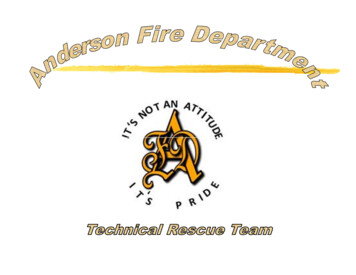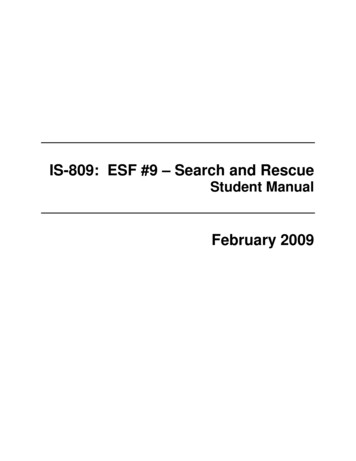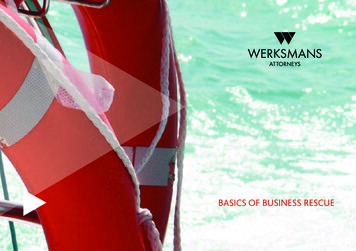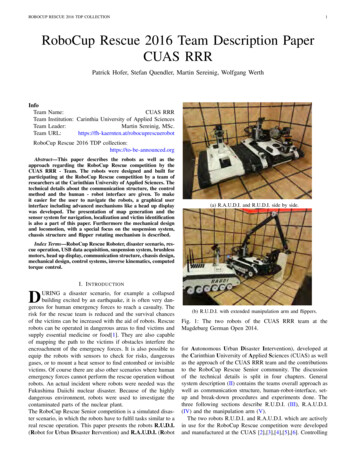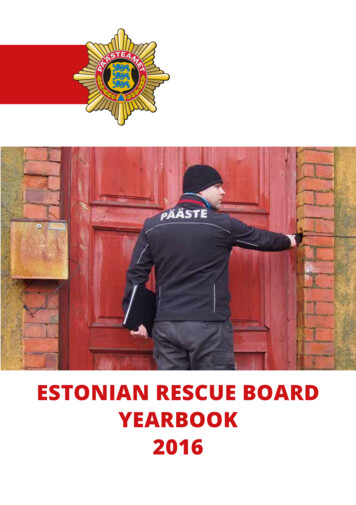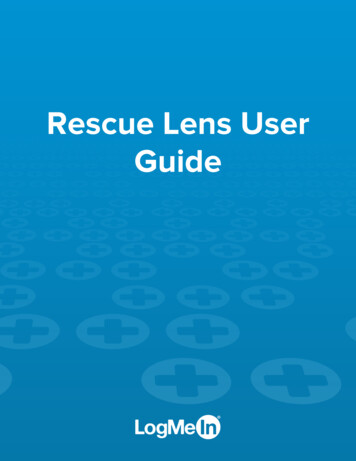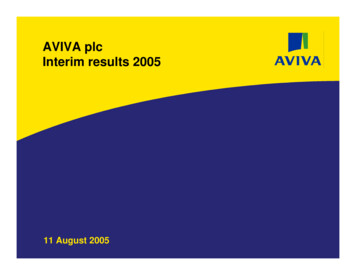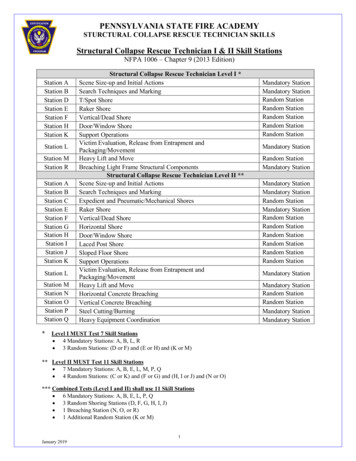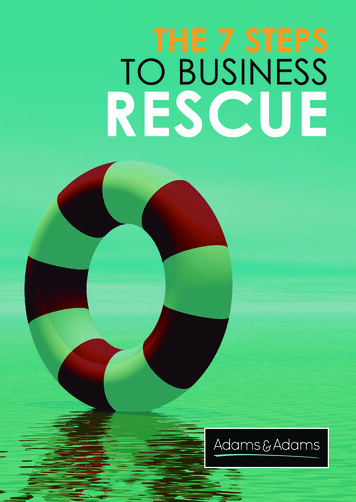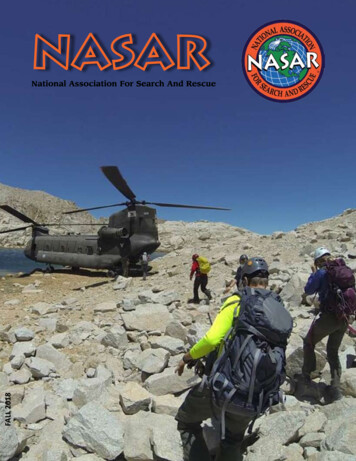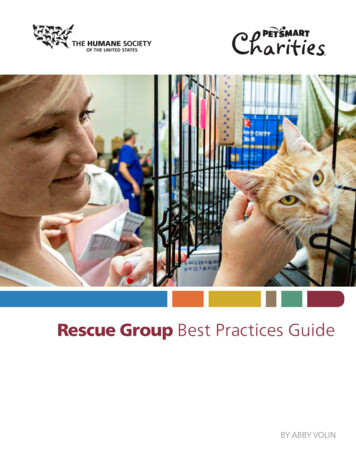
Transcription
Rescue Group Best Practices GuideBY ABBY VOLIN
This publication (Rescue Group Best Practices Guide) is intended to provide general information about rescue best practices. The information containedin this publication is not legal advice and cannot replace the advice of qualifiedlegal counsel licensed in your state. The Humane Society of the United Statesdoes not warrant that the information contained in this publication is complete,accurate, or up-to-date and does not assume and hereby disclaims any liabilityto any person for any loss or damage caused by errors, inaccuracies, or omissions.
TABLE OF CONTENTSACKNOWLEDGEMENTS . . . . . . . . . . . . . . . . . . . . . . . . . . . . . . . . IVINTRODUCTION . . . . . . . . . . . . . . . . . . . . . . . . . . . . . . . . . . . . . . . . VSECTION 1 ORGANIZATIONAL STANDARDSCREATING YOUR MISSION AND VISION . . . . . . . . . . . . . . . . . . . . . 1INCORPORATING AND APPLYING FOR501(C)(3) TAX-EXEMPT STATUS . . . . . . . . . . . . . . . . . . . . . . . . . . . . 2FORMING YOUR TEAM . . . . . . . . . . . . . . . . . . . . . . . . . . . . . . . . . . . . 3Building a Board of Directors . . . . . . . . . . . . . . . . . . . . . . . . . . . . . . . 3Building Your Staff . . . . . . . . . . . . . . . . . . . . . . . . . . . . . . . . . . . . . . . 5Building a Volunteer Network . . . . . . . . . . . . . . . . . . . . . . . . . . . . . . 11OBTAINING INSURANCE . . . . . . . . . . . . . . . . . . . . . . . . . . . . . . . . . 13CREATING A BUDGET AND BUSINESS PLAN . . . . . . . . . . . . . . . . 13FUNDING YOUR ORGANIZATION . . . . . . . . . . . . . . . . . . . . . . . . . . 14Types of Funds to Have . . . . . . . . . . . . . . . . . . . . . . . . . . . . . . . . . . . 14General fund . . . . . . . . . . . . . . . . . . . . . . . . . . . . . . . . . . . . . . . . . 14Spay/neuter and general veterinary expenses . . . . . . . . . . . . . . . . . . . . 15Specific medical cases . . . . . . . . . . . . . . . . . . . . . . . . . . . . . . . . . . . 15Creating a Development Plan . . . . . . . . . . . . . . . . . . . . . . . . . . . . . . 15Marketing and branding . . . . . . . . . . . . . . . . . . . . . . . . . . . . . . . . . . 15Fundraising . . . . . . . . . . . . . . . . . . . . . . . . . . . . . . . . . . . . . . . . . . 16Grant writing . . . . . . . . . . . . . . . . . . . . . . . . . . . . . . . . . . . . . . . . . 18Cost Containment . . . . . . . . . . . . . . . . . . . . . . . . . . . . . . . . . . . . . . 18IMPLEMENTING A CULTURE OF RESPECT . . . . . . . . . . . . . . . . . . . 18Engaging in Humane Discourse . . . . . . . . . . . . . . . . . . . . . . . . . . . . 19Preventing Compassion Fatigue . . . . . . . . . . . . . . . . . . . . . . . . . . . . 19Customer Service Skills . . . . . . . . . . . . . . . . . . . . . . . . . . . . . . . . . . . 20i
Rescue Group Best Practices GuideSECTION 2 ANIMAL CARE STANDARDSTHE FIVE FREEDOMS . . . . . . . . . . . . . . . . . . . . . . . . . . . . . . . . . . . . . 23STANDARDS FOR PRIMARY ENCLOSURES . . . . . . . . . . . . . . . . . . 26PHYSICAL WELL-BEING . . . . . . . . . . . . . . . . . . . . . . . . . . . . . . . . . . .28Vaccinations and Parasite Control . . . . . . . . . . . . . . . . . . . . . . . . . . . 29Disease Prevention . . . . . . . . . . . . . . . . . . . . . . . . . . . . . . . . . . . . . . 30Spay/Neuter . . . . . . . . . . . . . . . . . . . . . . . . . . . . . . . . . . . . . . . . . . . 30Microchipping . . . . . . . . . . . . . . . . . . . . . . . . . . . . . . . . . . . . . . . . . 31Food . . . . . . . . . . . . . . . . . . . . . . . . . . . . . . . . . . . . . . . . . . . . . . . . . 32Working with a Veterinarian . . . . . . . . . . . . . . . . . . . . . . . . . . . . . . 32MENTAL WELL-BEING . . . . . . . . . . . . . . . . . . . . . . . . . . . . . . . . . . . . 34Stress . . . . . . . . . . . . . . . . . . . . . . . . . . . . . . . . . . . . . . . . . . . . . . . . 34Enrichment . . . . . . . . . . . . . . . . . . . . . . . . . . . . . . . . . . . . . . . . . . . . 35Easy automatics . . . . . . . . . . . . . . . . . . . . . . . . . . . . . . . . . . . . . . . 35Win-wins . . . . . . . . . . . . . . . . . . . . . . . . . . . . . . . . . . . . . . . . . . . . 35In-cage enrichment . . . . . . . . . . . . . . . . . . . . . . . . . . . . . . . . . . . . . 36Out-of-cage enrichment . . . . . . . . . . . . . . . . . . . . . . . . . . . . . . . . . . 37Other stress relievers . . . . . . . . . . . . . . . . . . . . . . . . . . . . . . . . . . . . 38Socialization . . . . . . . . . . . . . . . . . . . . . . . . . . . . . . . . . . . . . . . . . . . 38VETERINARY POLICY . . . . . . . . . . . . . . . . . . . . . . . . . . . . . . . . . . . . . 38EUTHANASIA POLICY . . . . . . . . . . . . . . . . . . . . . . . . . . . . . . . . . . . . 39SECTION 3 OPERATIONAL STANDARDSRECORDKEEPING . . . . . . . . . . . . . . . . . . . . . . . . . . . . . . . . . . . . . . .TRANSPARENCY . . . . . . . . . . . . . . . . . . . . . . . . . . . . . . . . . . . . . . . .DETERMINING CAPACITY . . . . . . . . . . . . . . . . . . . . . . . . . . . . . . . .EXCEEDING CAPACITY . . . . . . . . . . . . . . . . . . . . . . . . . . . . . . . . . . .ANIMAL INTAKE . . . . . . . . . . . . . . . . . . . . . . . . . . . . . . . . . . . . . . . .Sources of Animals . . . . . . . . . . . . . . . . . . . . . . . . . . . . . . . . . . . . . .Creating a Plan . . . . . . . . . . . . . . . . . . . . . . . . . . . . . . . . . . . . . . . . .Partner with a Local Shelter . . . . . . . . . . . . . . . . . . . . . . . . . . . . . . .Pet Retention Strategies . . . . . . . . . . . . . . . . . . . . . . . . . . . . . . . . . .ii414243454747485052
Table of ContentsOwner Surrenders . . . . . . . . . . . . . . . . . . . . . . . . . . . . . . . . . . . . . . . . . 53Strays . . . . . . . . . . . . . . . . . . . . . . . . . . . . . . . . . . . . . . . . . . . . . . . . 54Temporarily Holding an Animal . . . . . . . . . . . . . . . . . . . . . . . . . . . . 54Use of Boarding Facilities . . . . . . . . . . . . . . . . . . . . . . . . . . . . . . . . . 55Transporting Pets . . . . . . . . . . . . . . . . . . . . . . . . . . . . . . . . . . . . . . . 55SHELTER-TYPE FACILITIES . . . . . . . . . . . . . . . . . . . . . . . . . . . . . . . . .PROGRESSIVE ADOPTIONS . . . . . . . . . . . . . . . . . . . . . . . . . . . . . . .Process . . . . . . . . . . . . . . . . . . . . . . . . . . . . . . . . . . . . . . . . . . . . . . .Setting Your Adopters Up for Success . . . . . . . . . . . . . . . . . . . . . . . .Events and Other Advertising . . . . . . . . . . . . . . . . . . . . . . . . . . . . .FOSTER HOMES . . . . . . . . . . . . . . . . . . . . . . . . . . . . . . . . . . . . . . . .DISASTER PREPAREDNESS . . . . . . . . . . . . . . . . . . . . . . . . . . . . . . . .56575760616263SECTION 4 COMMUNITY BUILDINGWITH OTHER ANIMAL WELFARE ADVOCATES . . . . . . . . . . . . . .Potential Partners to Increase Lifesaving Efforts . . . . . . . . . . . . . . . .Building a Transfer Program with Local Shelters . . . . . . . . . . . . . . . .Building a Transfer Program with Out-of-State Rescues . . . . . . . . . .Building Coalitions . . . . . . . . . . . . . . . . . . . . . . . . . . . . . . . . . . . . . .WITH YOUR SUPPORTERS . . . . . . . . . . . . . . . . . . . . . . . . . . . . . . . .Website . . . . . . . . . . . . . . . . . . . . . . . . . . . . . . . . . . . . . . . . . . . . . .Social Media . . . . . . . . . . . . . . . . . . . . . . . . . . . . . . . . . . . . . . . . . . .6565676870717171APPENDIX(These documents can be found at animalsheltering.org/rescuebestpractices)A. SAMPLE BUSINESS PLANB. SAMPLE BUDGETC. SAMPLE EUTHANASIA POLICYD. SAMPLE INTAKE PLANE. SAMPLE PET RELINQUISHMENTF. SAMPLE TEMPORARY PET RELINQUISHMENTiii
ACKNOWLEDGEMENTSTHE FOLLOWING GUIDE IS A RESOURCE PRODUCEDTHROUGH A COLLABORATIVE EFFORT BETWEEN PETSMART CHARITIES AND THE HUMANE SOCIETY OF THE UNITED STATES.We offer our sincere thanks to the people who provided their wisdom and insightsto make this publication as useful as possible to the rescue community, as well asthe individuals who reviewed this guide: Todd Cramer, Amber Sitko, Jan Elster,Kaylee Hawkins, Stacy Smith, Kathy Gilmour, Mandi Wyman, Whitney Horne, BritneyWallesch, Carie Broecker, Laura Pople and Jme Thomas. We would also like toacknowledge contributions from HSUS staff: Betsy McFarland, Inga Fricke, NatalieDiGiacomo, Sarah Barnett, Hilary Hager, Kathleen Summers and Joyce Friedman.Last but not least, we extend our gratitude to all the rescue groups who work tirelesslyto help homeless pets.ABOUT PETSMART CHARITIES PetSmart Charities, Inc. is a non-profit animal welfare organization that saves thelives of homeless pets. More than 400,000 dogs and cats find homes each yearthrough our adoption program in all PetSmart stores and our sponsored adoptionevents. PetSmart Charities grants more money to directly help pets in need than anyother animal welfare group in North America, with a focus on funding spay/neuterservices that help communities solve pet overpopulation. PetSmart Charities is a 501(c)(3) organization, separate from PetSmart, Inc. To learn more about how PetSmartCharities is working toward its vision of a lifelong, loving home for every pet, call1-800-423-PETS (7387) or visit petsmartcharities.org.ABOUT THE HUMANE SOCIETY OF THE UNITED STATESThe Humane Society of the United States (HSUS) is the nation’s largest andmost effective animal protection organization. Established in 1954, The HSUSseeks a humane and sustainable world for all animals—a world that will also benefitpeople. The HSUS is America’s mainstream force against cruelty, abuse, and neglect,as well as the most trusted voice extolling the human-animal bond. The HSUS worksto reduce suffering and to create meaningful social change by advocating for sensiblepublic policies, investigating cruelty, enforcing existing laws, sharing information withthe public about animal issues, joining with corporations on behalf of animal-friendlypolicies, and conducting hands-on programs that make ours a more humane world.iv
INTRODUCTIONRESCUE GROUPS ARE VITAL IN THE WORLD OF ANIMAL WELFAREAND ARE COLLECTIVELY RESPONSIBLE FOR SAVING HUNDREDS OFTHOUSANDS OF ANIMALS EVERY YEAR. Oftentimes, rescue groups go outof their way to take the cases that shelters do not have the resources to help, makingtheir partnerships invaluable. They are incredible, lifesaving organizations. But whatdoes it mean to be a rescue? Does it simply refer to an organization that takes inhomeless animals and finds them a home? Does it mean being part of an organizationwith 501(c)(3) nonprofit status? Does it mean the rescue provides trap-neuter-returnservices to community cats? Actually, a rescue can meet all or none of these criteria.This manual was designed to provide structure and guidance to all types of rescuegroups. It describes best practices for these organizations and, perhaps moreimportantly, suggests ways to implement them to help rescues operate at theirmaximum potential. This guide can be used to evaluate the health of establishedorganizations, as well as help new groups get off to a successful start.While there is no one-size-fits-all way to run a rescue group, there are standards—both from an organizational and animal care standpoint—that all rescue organizations should meet. Above all, rescuers owe it to the animals in their care to runtheir rescue operations in the most professional, collaborative and humane manner.Ultimately, as rescue groups adhere to best practices, they become more efficientand effective. This allows rescuers not only to humanely take in and adopt out moreanimals, but also build trust within the community, work successfully with otherlocal animal welfare advocates and help solve the problem of pet homelessnesson a community level.v
Rescue Group Best Practices GuideSECTION 1ORGANIZATIONAL STANDARDSvi
Organizational StandardsRescue organizations should be run just like any otherbusiness. With a solid foundation in place, you will havemore support to grow your rescue group, allowing youto bring in more animals and save more lives.CREATING YOUR MISSION AND VISIONIf you are thinking about starting a new rescue group, define your mission and visionbefore you do any other planning. Where is the greatest need in your community?What do you hope to accomplish and why? Conducting a community assessmentcan assist you in determining the type of help the animals in your community need.Typically, forming a rescue group consists of creating an organization that takesin animals that have been transferred from a shelter, relinquished by their owneror found as a stray; fosters them in a home environment; and adopts them out.Although these foster-based organizations are crucial to lifesaving efforts, generallytheir mission is not to stop the problem of pets becoming homeless in the first place.There are other ways to help. Consider the needs in your community before decidingwhat type of rescue group you want to start. Nearly every community could use morefoster-based organizations, but if the market is already saturated with those, you maywant to think about creating a prevention-based organization that keeps pets in theirhomes and stops them from entering the shelter and rescue system in the first place.Your organization can be at the bottom of a broken dam with buckets to lessen thedeluge of rushing water or you can start from the top and plug the holes to preventthe water from leaking. Prevention-based organizations might focus on low-cost spay/neuter, lost-and-found, behavior assistance, legal assistance, pet food pantry operation or other valuable programs.1
Rescue Group Best Practices GuideINCORPORATING AND APPLYINGFOR 501(C)(3) TAX-EXEMPT STATUSWHY: Incorporating as a business in your state is an easy way to show the worldthat your rescue group is a legitimate business venture and that you are treating itas such. Further, the corporate formation protects individuals in the organizationfrom legal liability and debt incurred by the rescue group. More importantly, yourorganization has a significantly better chance of being approved for 501(c)(3) taxexempt status if you incorporate. And having that tax-exempt status is crucial foryour organization’s ability to grow. Not only is the organization exempt from federalincome tax, but you can entice donors with a tax deduction for any contributionsand apply for the many grants that are awarded only to nonprofit organizations.Nonprofits can also apply for a mailing permit that gives them a special reducedrate for mailings.HOW: Check your state’s requirements for incorporating a nonprofit with yourstate’s corporate filing office (usually called the department of state, secretaryof state or something similar) and check out other resources. Contact the stateoffice responsible for businesses to find out what your state’s specific requirementsare or check out the comprehensive state-specific resources. Many offices will provide a packet of information on how to incorporate along with sample documents.You will also need to draft articles of incorporation and bylaws in conjunctionwith incorporating your organization, which are the primary rules governingthe management of your corporation. Even if your state does not require bylawsas a matter of law, it is still a good idea to draft them as they define your businessstructure and specify how your organization will conduct its affairs.You can find samples for drafting articles of incorporation and state specificsamples. When you are ready to apply for tax-exempt status, all the informationyou need is on the IRS website. Keep in mind that it can take many months toobtain 501(c)(3) status, so do not get discouraged. Moreover, you may wantto consult with an attorney or accountant who specializes in nonprofits, evenif it is just to review the completed application.Also remember to check if your state has specific licensing requirements, if any,for operating a shelter or rescue group. You can usually find any laws pertainingto animals in your state’s agriculture code.For more information, check out the Rescue Central resources on Starting a RescueGroup, especially the presentation Obtaining Tax Exemption for Your Organization.2
Organizational StandardsFORMING YOUR TEAMEvery rescue group needs three layers of support to build a full team. At the top isthe board of directors. These are the members who oversee the strategic direction,or long-term planning, of an organization. The next layer consists of staff, includingan executive director, who runs the day-to-day operations of the rescue group. Somerescue organizations are able to pay a few staff members, but generally these groupsrely on volunteers. It is still important to call these dedicated members “staff” regardless of whether they are paid, because it demonstrates that your organization is runprofessionally. Doing so also gives individuals a sense of ownership, responsibilityand appreciation for the hours they contribute. The final layer of your team is thevolunteers—people who help out on a regular basis by supporting the staff. Whetherthey foster animals, help out at adoption events, transport animals to veterinarianappointments or participate in countless other activities, volunteers are the lifebloodof any rescue group.BUILDING A BOARD OF DIRECTORSEvery organization has a board of directors, which is a body of elected or appointedmembers who oversee the activities of the corporation. Their responsibilities aredetailed in the organization’s bylaws, but typically, members of the board are responsible for governing the organization, appointing and reviewing the executive director,approving budgets, approving an organization’s policies and other similar tasks. Boardmembers have an obligation of allegiance, care and duty to the organization. Forrescue groups, it is important to recruit people who will help the organization fulfillits mission statement by providing advice and implementing long-term goals that willassist the organization plan for the future and create the vision of what it will become.Board members are not the ones who run the day-to-day aspects of the rescue group(unless the organization has a “working board,” where board members double asstaff), but instead are involved in strategic planning. That is, how will the organizationget from where it is today to where it wants to be in a few years? The board of directors is a group who advances the organization’s mission by providing advice, money,time and expertise. A sample strategic plan devised and implemented by a board ofdirectors may be helpful.Generally, board members on working boards are expected to be heavily involvedin strategic planning, fundraising, and policy decisions for the organization. Whenforming your board, think about the type of people who are going to help fulfillthe organization’s mission and goals: Someone with fundraising abilities? Public3
Rescue Group Best Practices Guiderelations or marketing savvy? Legal or accounting abilities? Management background? Political connections? Choosing friends and family to serve on your boardmay be necessary at first, but once you become established you will want to be morestrategic in selecting board members. An independent board is important for yourorganization’s credibility. Having family members on the board could be viewednegatively, so it is an important point to consider.Check the laws in your state to determine the exact number of people you needon a board, but at a minimum you will need to have a president, a secretaryand a treasurer. The executive director is not normally a board member, butis instead accountable to the board of directors and also serves as the bridgebetween the board and the staff who carry out the day-to-day functions ofthe organization. Board members will need to be willing to commit their timeand resources to the organization. You may want to implement term limits formembers of the board or have non-voting members who are there exclusivelyin an advisory role. It is helpful to have a job description so that prospectivemembers will know what will be expected of them.Importantly, the board of directors is responsible for approving new contracts (suchas foster agreements or adoption contracts) and authorizing certain individuals (usually the executive director, the board president and the board vice-president) to signdocuments on the organization’s behalf. You may also want the board to authorizespecific individuals to sign agreements relevant to their area of expertise. For example, the board might allow the adoption coordinator to sign adoption contracts orauthorize the volunteer coordinator to sign volunteer agreements.In keeping with good practices and building a trustworthy organization, it is important for the board to create well-documented polices that foster transparency. Forexample, it is essential to have a conflict of interest policy for the board of directors,document retention policy, code of ethics, whistleblower policy and, if applicable,written compensation practices.A strong board of directors is vital to the current success and future developmentof your rescue group. Pick your board members thoughtfully!For more information, check out the Rescue Central resources on BuildingEffective Boards.4
Organizational StandardsBUILDING YOUR STAFFWhile the Board of Directors is accountable for the long-term goals of the organization, the staff is responsible for running the day-to-day operations of the rescuegroup. After you have filed the articles of incorporation and applied to the IRS fortax-exempt status, the next important task is developing your team. Although themajority of your staff will be unpaid volunteers with other jobs and obligations, itis crucial that all individuals involved are committed to their positions to ensurethat the rescue runs as smoothly as possible.Do not put someone into a role simply because they offered or because you are eagerto fill the position. The person’s skills must align with the post. For example, the outgoing individual who loves meeting new people but has never balanced a checkbookwould better serve the organization as a volunteer coordinator than the financialcoordinator. Similarly, the individual who does not bat an eyelash at mounds of paperwork, yet gets easily stressed by demanding customers, might be a great fit for therecords manager but not the adoption coordinator. Do not be afraid to move peoplearound and try them in different roles until you have the right fit. Even though it maybe difficult to leave a crucial position empty until you find the perfect match, in thelong-run your organization will be much better off having the right people in place.5
Rescue Group Best Practices GuideBelow is a basic template to use in building your rescue group’s staff, includingsuggestions for job responsibilities and helpful skills. This list is not meant to beall-inclusive, so use it as a starting point and tweak it to fit the needs of your organization. And do not be afraid to split these positions among several people—thereis plenty of work to go around! Just remember that you do not need to fill all thesepositions immediately. Start small and continue to build as your rescue group gainsmore volunteers. Once your rescue group is established, it is certainly appropriate topay staff according to the laws of your state. Organizations that have paid staff findthat it leads to less turnover and more consistent policies and procedures.» EXECUTIVE DIRECTORThis person is the face of your organization and chosen by the boardof directors. In addition to being the rescue group’s spokesperson,this individual is responsible for the day-to-day operations of theorganization and interacts with the board of directors as well as theother staff members and volunteers. The executive director ensuresthat the organization is operating according to its mission statementand developing funds and policies for its future. The individual in thisposition should have business and media savvy as well as a considerableamount of patience and tact.» RECORDS MANAGERAn obsessively organized and detail-oriented volunteer should fill this post.This individual should be tech savvy as she will be dealing with all paperworkand the animal management software. The records manager will updateeach animal’s profile with current location, medical history, and outcome, aswell as update bios and pictures for the group’s website and other listings. Asyour organization grows and the number of animals coming in and out ona weekly basis explodes, this becomes one of the most overwhelming jobs.Find a couple of people to share the work or rotate the responsibilities everycouple of months.» FINANCIAL COORDINATORWhich one of your friends is an accountant or math whiz? This personmight be a good candidate to keep track of the organization’s finances,both outgoing expenses and incoming donations. When it comes time tofile your 990 tax returns with the IRS, this person will prepare the information for your group’s accountant. If someone in your rescue group orcommunity is an accountant, ask if he will donate his services come taxtime. If you do not have this type of contact, seek help from a professional.If your rescue group has its 501(c)(3) status, you can inquire about receivinga reduced rate.6
Organizational Standards» CORPORATE RELATIONS COORDINATORYou need someone who can reach out to corporations, such as pet storesor big box chains, and other service providers to negotiate prices for food,veterinary services, transport, and other items to allow your rescue tominimize expenses.»F ACILITY DIRECTORAre you going to have a brick-and-mortar facility to house some or allof your animals? Or even a few cages in a storefront? If so, you will needsomeone to run each facility. Preferably, this person will live close to thefacility because she will have to be at the location on a frequent basis,including during emergency situations. The facility director will create protocols to care for the animals and ensure their well-being, as well as train,schedule and supervise volunteers. This position is ideal for someone withcommunity outreach experience who can turn a job cleaning cages intoa fun task in which volunteers feel invested. Good people skills are also amust as this person will be the face of the organization at that facility. Prioranimal care experience and knowledge of shelter cleaning protocols areessential. It is critical to have someone on staff who knows how to handleunvaccinated animals, puppies with parvovirus, kittens with panleukopenia, proper cleaning solutions and ratios and a host of other common issuesprevalent in animals that come from a shelter. This person should alsobe familiar with The Association of Shelter Veterinarians’ Guidelines forStandards of Care in Animal Shelters, which outlines best practices for running an animal facility, and understand how to implement these standards.When setting up your own facility, be sure to look into local kennel orzoning ordinances at the outset. Many other issues will have to be considered as well, such as how to fund the facility and deal with challenges suchas neighbors who may oppose your group’s presence.» FOSTER COORDINATORThis position requires someone with a lot of patience and good peopleskills. The foster coordinator needs to give prospective foster providersa clear list of what the group will provide and what the foster
Rescue Group Best Practices Guide) is intended to provide gen-eral information about rescue best practices. The information contained in this publication is not legal advice and cannot replace the advice of qualified legal counsel licensed in your state. The Humane Society of the United States does not warrant that the information contained in this publication is complete, accurate, or up-to .
